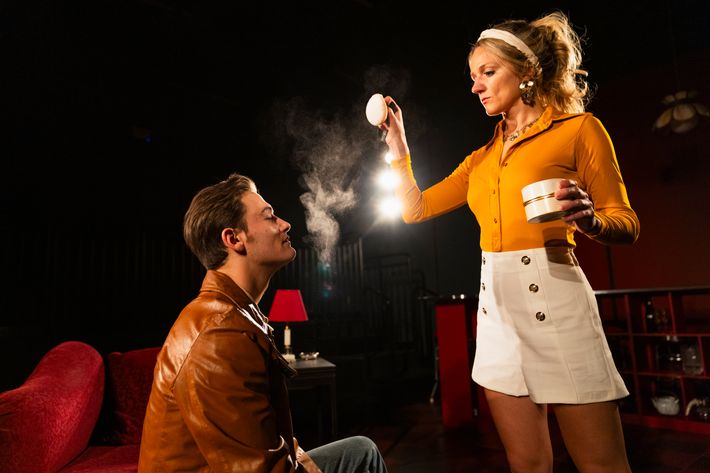
Fifty years into whatever we’ve chosen to do with our lives, may we all be as vigorous, mischievous, and curious as Talking Band. The company—founded by Ellen Maddow, Tina Shepard, and Paul Zimet in 1974—is celebrating half a century of experimental theater-making, and in barely three months, it’s premiered as many new shows. The Following Evening, written for Maddow and Zimet by Abigail Browde and Michael Silverstone of 600 Highwaymen, was a gorgeous meditation on coupledom, creative labor, and the passage of time; in its own way, so was Existentialism, based on the work and lives of Jean-Paul Sartre and Simone de Beauvoir and directed by the company’s longtime collaborator Anne Bogart. Do the members of Talking Band repeat themselves? Only inasmuch as expert composers do. Here’s Rhonda, a sales clerk at the eponymous clothing store in the new Shimmer and Herringbone (written by Maddow and Zimet and directed by Zimet), talking to a customer who is both wearing and trying on plaid flannel:
Rhonda: Did you find what you were looking for?
Gus: I’m not sure yet. I’ll see how these look on me.
Rhonda: You like plaids.
Gus: I do.
Rhonda: Have you read The Book of Tea?
Gus: No.
Rhonda: The guy who wrote it calls the Tea House “The Abode of the Unsymmetrical.” If you have a live flower you don’t have a painted one; if it is snowing outside you don’t show white plum blossoms. He says repetition is regarded as lack of tact.
Gus (indicating his armful of shirts): I call this variation.
Rhonda: Variation’s good. Especially after this winter.
Gus: You can say that again.
Rhonda: That would be repetition.
The whole exchange takes no more than 30 seconds, and, like so many of the riffs and runs in Shimmer and Herringbone, it feels like a perfect microcosm of Maddow and Zimet’s writing. It’s playful, erudite (without a breath of condescension in the delivery), peppered with wit, and glistening with wry double meanings. “Did you find what you were looking for?” Well, Rhonda, how long do you have? Later, another customer named Colin (Jack Wetherall) asks Rhonda (Maddow, who’s just magical) whether a colorful shirt is “too frivolous.” “For what?” she asks. “For these times,” he replies ruefully. Rhonda pauses and then looks into the invisible mirror—out toward the audience—along with him. “You mean,” she says, “do you have a right to be happy?”
For Maddow and Zimet, any setting is an opportunity to peep through a specifically shaped pinhole out into the infinite mystery. Starting with clothing, they can reflect on identity (private, public, performed), on the intimacy of the dressing room and the psychological freight of the mirror, the existential echoes of tiny choices and the ephemera we collect and outgrow. Shimmer and Herringbone is structured around a series of interactions—at first fleeting, then increasingly entwined—in and around said clothing store. (Is it a thrift shop? A boutique with inexplicable taste? The delightfully chaotic combination of garments on stage provides no answer.) There’s Rhonda, Maddow’s wonderful sales associate — quippy, upbeat, cosmically curious and calm, and sporting a bright red Edna Mode bob (Olivera Gajic designed the show’s lighthearted whirl of costumes). There’s Gus (James Tigger! Ferguson), the chronic plaid-wearer, who chats with Rhonda about Chekhov and eventually reveals that a windfall inheritance from his aunt has elevated him from humble teacher to owner of the building in which “Shimmer” rents the ground floor. Wetherall’s Colin, an aging TV idol of the General Hospital variety, moves in upstairs, thanks to Grace (Louise Smith), another shop regular who’s a trendy, harried real-estate agent. (Her speech to Rhonda about the eerie erasure of character involved in “staging a house”—“you paint the walls dove white, put in cream carpets … hang seascapes in the living room”—is another moment that resonates beyond the literal.) Grace, for her own emotional reasons, is currently avoiding her best friend, Lilly (the spot-on Lizzie Olesker), a frazzle-haired, pigeon-obsessed ornithologist. And Lilly’s no-nonsense daughter, Bree (Ebony Davis), is just visiting, although she’s getting more and more fascinated by Melanie (Tina Shepard), an elderly stranger with an ever-transforming appearance, a mysterious backstory, and a mien as haughtily queenly as her balance is unsteady.
Everyone is a delight, and Shepard is absolutely grand. At once dainty and iron-spined, she stares chin-up into the distance with the kind of hard, strange gaze that convinces anyone who passes that she must be looking at something — and she is, whether or not they can see it. She’s weird, a little witchy, and devastatingly blunt. “Pigeons?” she snorts when Lilly reveals her life’s work. “I hate ’em. All they do is coo and poo and screw.” Through their chance encounters at Rhonda’s clothing shop, all Maddow and Zimet’s characters are headed for a wild night of the soul — a kind of bacchanal of insomnia, where reality is transcended, magical basements are discovered, and people start to speak their hearts, to see and be their fuller selves. (After all, how could the first ever “King of Boylesque” be content with nothing but jeans and plaid flannels?) “How do you know it’s a he?” Colin—who has emerged, radiant, in a black dress and reintroduced herself as Coleen—asks Lilly, who’s holding a pigeon. Lilly explains that, while “it’s really hard to tell with pigeons,” the most reliable way is to turn them over and gently press their feet down: “If the feet spring back when you release your hand, it’s a male.” Coleen and Grace both consider this. “I’m not sure if my feet would spring back or stay put. Maybe a little of both,” muses Coleen. Grace nods. “Maybe,” she says, “it would depend on who pushed them down.”
There’s a beautiful expression that, at some point, passes over the face of everyone in Shimmer and Herringbone. It’s that look you get when you learn something new, a funny little fact from the universe’s limitless library, and you look up, cock your head slightly, and, half smiling, go, “Huh.” Maddow and Zimet’s work dances constantly with that moment — with vital injections of realization and wonder, the antidote to all that’s inward-turning and self-serious. “I must remind myself how fucking beautiful the world can be,” sings Rachel Feldhaus, one of the show’s musicians, a string trio that scores the play’s action with looping, entrancing music also written by Maddow. Repetition, variation, discovery, awe, back to work — it turns out we are still talking about how to make a play, and how to be a person. “Isn’t it amazing,” reflects Gus, “that there is so much different music when there are so few notes?”
Up at A.R.T., Peregrine Teng Heard’s Redemption Story is also moving through variations on a theme. Heard is the artistic director of the Associates, a theater company that creates new plays exploring, in their words, “the paradox at the heart of American modes of identity.” Here, America takes one of its most popular synecdochic forms: Hollywood, specifically the gritty-shiny dream factory of L.A. in 1971. Though we’re in the year of The French Connection and Dirty Harry, Heard’s play and Sarah Blush’s direction often aim to evoke the noir of the 1940s. Characters light cigarettes with sultry indifference; actors pivot a spotlight on a rolling floor-mount to catch each other in the accusing glare or carve out menacing silhouettes; and Heard’s protagonist, an aging actress named Connie Lee (Christine Toy Johnson), speaks with the Tennessee Williams–ish height and flourish of one of those dames whose entrance spells trouble.
“I’ve got my sunset haze on,” Connie, doped up, purrs at Billy Jay (José Espinosa), a beautiful young man she’s taken under her wing. “Don’t break the haze.” And later, still to Billy: “You’ve got destiny draped across your shoulders like a cape of diamonds.” Connie’s heyday was the ’40s and ’50s—thus the play’s stylistic vernacular—but can it really be called a heyday when your whole career was built on exploitation? Connie is East Asian, and as her friend Eva (Dee Beasnael) reminds her, “They killed every character you played.” A former actor and a Black woman who decisively stepped away from industry racism to run her own diner, Eva has more than a raised eyebrow for the romanticism Connie still wears like her own diamond cloak. But Connie can’t, or won’t, help it. When Billy Jay rolls into town with a scrubbed face, a single suitcase, and the golly-gee dream of making it big on the radio, she slips his name to a producer and him into her pocket. Her reasons for wanting to make the kid into a star are manifold and messy: She’s got plenty to atone for, and plenty of her own buried suffering goading her on.
Along with everybody else in Redemption Story, Connie wants — well, it’s right there in the title. Everyone, from the hungry-eyed model Florence (Emily Stout) to the aspiring actor Baker (Gregory Saint Georges) to Connie’s estranged son, Harrison (Mitchell Winter), is seeking the new, purified life, the second chance. For all its mystery, noir isn’t necessarily a subtle genre, and that heavy underlining of theme wants to feel intentional in Heard’s play, though it doesn’t always stick the landing. That’s true in general of the piece, which comes in and out of focus as it goes. The show is most acute in its observance of the disturbing, still-familiar power constellation among the characters: It’s clear who pours their lifeblood out for the industry while being stereotyped and stepped on, and who gets to walk into rooms with only a square jaw and a glinting smile and win the part — and, to her credit, Heard doesn’t hammer this stuff home; she simply shows it in action. Espinosa’s Billy Jay is also a huge asset: His vacillation between cornfed, charming-despite-yourself naïveté and furtive, ambitious, even possibly sinister unknowability is—perhaps a little ironically—the play’s most compelling character arc.
But there’s also a two-thirds-of-the-way-there feeling to much of Redemption Story, especially in Blush’s direction. The production is noir-ish, but it doesn’t go all out — it pauses somewhere between high style and relatable realism when it could take the plunge. During certain scenes, I realized I was hearing the swell of Max Steiner strings or the shady skulk of Bernard Herrmann horns and cymbals, but only in my own head. At other moments, the conversation on stage began to feel underpowered, dropping in palpable stakes as it dropped the trappings of a more formal container. Especially since Heard is pushing the broken, beguiling Connie further and further away from the play’s titular state of grace, it feels as if she and Blush could both risk painting with bolder brushes. After all, there’s more than a touch of evil at work in the forces that Redemption Story sets out to explore.
Shimmer and Herringbone is at Mabou Mines through May 19.
Redemption Story is at A.R.T./New York Theatres through May 19.



